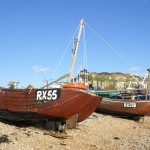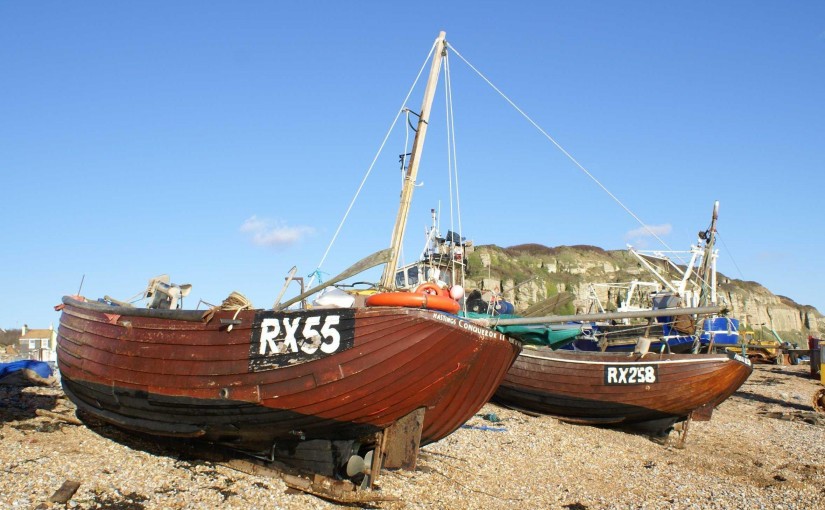By Tim Lambert
SAXON HASTINGS
Hastings began as a Saxon settlement. It was called Haesta ingas, which means Haesta’s people. By the 10th century Hastings had grown into a little market town. It even had its own mint.
However Hastings was very small with a population of only several hundred. In 1011 the Danes sacked Hastings but it soon recovered. From the 11th century Hastings was one of the Cinque ports, a group of 5 ports who were supposed to provide ships for the king in time of war in time of war in return for certain privileges. However this custom died out in the 15th century and a more modern navy was formed.

HASTINGS IN THE MIDDLE AGES
After the Norman Conquest in 1066 a castle was built at Hastings. At first it was built of wood but it was soon rebuilt in stone. However by the 15th century Hastings castle had fallen into a state of disrepair.
St Clement’s Church was built in the late 14th century. All Saints Church was built in the 15th century. From the end of the 12th century Hastings had a priory (a small abbey).
In the Middle Ages Hastings flourished as a fishing settlement and a small market town. Fishermen from Hastings fished in the North Sea off East Anglia and they sold much of their catch in Great Yarmouth. However Hastings failed to develop into a major port because the harbour silted up. Hastings also suffered from floods. In 1339 and 1377 Hastings suffered disaster when it was attacked by the French and burned. That was an easy task as most of the buildings were of wood with thatched roofs. However they could be easily built.
A stone wall was built south of Hastings, probably in the late 14th century to protect the town from attack from the sea. However by the 18th century this wall had fallen into ruins.
HASTINGS IN THE 16th AND 17th CENTURIES
In the 16th century and 17th century Hastings slowly grew. In 1589 Queen Elizabeth granted Hastings a charter (a document granting the townspeople certain rights). Hastings gained a corporation and a mayor.
Like all towns in those days Hastings suffered from outbreaks of the plague. It struck in 1563, 1590 and 1597. However each time the population of the little town recovered.
Hastings Grammar School was founded in 1619.
In the early 18th century Hastings was a small market town with a population of about 1,500. Apart from fishing Hastings in the 18th century Hastings was famous (or infamous) for smuggling. Other industries in Hastings were shipbuilding and rope making.
HASTINGS IN THE 18th CENTURY
From the 18th century Hastings began to develop as a seaside resort. In the latter part of the century it became fashionable among the wealthy to spend a Summer by the sea. Many people believed that bathing in sea water was good for your health.
The first guide to Hastings was printed in 1794. Marine Parade was begun in 1797.
HASTINGS IN THE 19TH CENTURY
By 1801 Hastings had a population of 3,175. It would seem tiny to us but by the standards of the time it was a small town. Hastings grew at a tremendous rate in the 19th century. By 1851 the population of Hastings was 17,621. By the end of the century it had passed 65,000.
The new seaside resort grew rapidly although fishing remained the main industry in Hastings. In the 1820’s Pelham Place and Crescent were built. So were Castle Street and Wellington Place.
There used to be a stream called the Bourne, which flowed through the centre of the old town. It was covered over in 1834. Today it lives on as the name of road. Also in 1834 headland called White Rock was removed to improve communications.
There were several improvements in Hastings in the 19th century. In 1820 a Paving and Improvement Act was passed by Parliament. This formed a body of men to pave, clean and light the streets. Hastings gained its first newspaper in 1830. Also in 1830 Hastings obtained gas light. In 1833 a piped water supply was created. The first real police force in Hastings was created in 1836. The railway reached Hastings in 1851.
Holy Trinity Church was built in 1858. The first fire brigade in Hastings was formed in 1861. Queens Hotel was built in 1862. Also in 1862 a Clock Tower was erected. Hastings Pier was built in 1872.
St Mary Star of the Sea was built in 1883 by a poet named Coventry Patmore as a memorial to his wife.
A museum was founded in Hastings in 1879. Hastings Town Hall was built in 1881. Alexandra Park opened in 1882. Also in 1882 the first electric light was generated in Hastings. West Hill Lift was built in 1891.From 1830 Hastings faced competition from a new seaside resort at St Leonards, which was created by a man named James Burton. However in 1885 the Old Town, the modern town and St Leonards were joined together to form one borough.
HASTINGS IN THE 20th CENTURY
By 1901 the population of Hastings had risen to 65,528. East Cliff Railway was built in 1902.
Royal East Sussex Hospital opened in 1923.
White Rock Pavilion was built in 1927. Marina Court was built in 1938.
During World War II Hastings was bombed several times and 154 people were killed. Over 15,000 buildings were destroyed or damaged.
Today there is still a fishing industry in Hastings and a new fish market was built in 1993. Meanwhile the tourist industry is booming. The Corporation bought Hastings Castle in 1951. The Fishermen’s Museum opened in 1956. White Rock Theatre opened in 1985. The Shipwreck Heritage Centre opened in 1986. Priory Meadow Shopping Centre opened in 1996.
HASTINGS IN THE 21st CENTURY
Underwater World opened in 2000. Hastings Skate Park was built in 2001. Today the population of Hastings is 85,000.
“Rye’s Own” May 2008
All articles, photographs and drawings on this web site are World Copyright Protected. No reproduction for publication without prior arrangement.
